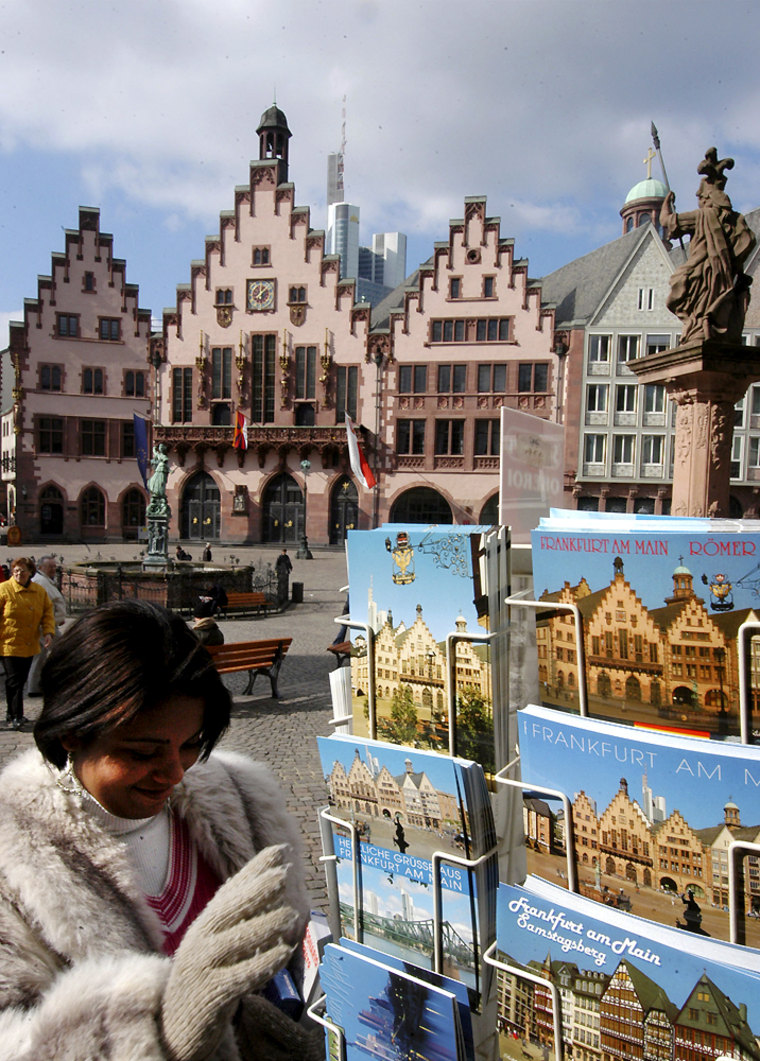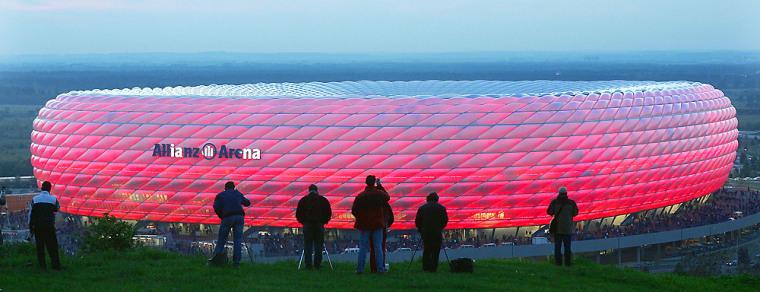Next month in Germany, more than a million visitors will marvel at world-class play during the World Cup soccer championship. They can also admire great art, stroll medieval town squares and savor some of the world's best beer.
The World Cup offers great tourism as well as sport, with the 12 host cities including perennial travel favorites Berlin, Cologne, Munich, Nuremberg and Hamburg. With as little as two or three spare hours before a game, visitors can take in Albrecht Duerer's "Self-Portrait" in Munich's Alte Pinakothek art museum - or try a crisp-roasted schweinshaxe, or ham hock, with sauerkraut and a cold pilsner from a centuries-old local brewery.
Visitors during the June 9-July 9 tournament won't even need tickets to plug into the soccer excitement. Games will be shown live on big screens in public places such as Berlin's Potsdamer Platz and Munich's Olympic Park, and thousands of people are expected to take part in fan festivals around the country.
Berlin alone is expecting 300,000 overnight guests, but tourism authorities say there will be room. "Whoever comes will always find a hotel bed," promised Hanns Peter Nerger, head of Berlin's tourism marketing operation.
Of course, one can even forget the soccer. As with Athens and the 2004 Olympics, the week after the event ends might be a good time to visit, since some hotels are raising hotel prices on game days.
Here are leading attractions for quick visits in the top cities:
- BERLIN: The museums clustered on the Museum Island in the Mitte district are superb, led by the Pergamon Museum with its 2nd century B.C. altar from the Greek city of Pergamon, and the blue-tiled Ishtar Gate built during the reign of Nebuchadnezzar II around 575 B.C. in ancient Babylon, now in Iraq. In the nearby Altes Museum, you can see the exquisite, 3,300-year-old bust of Egypt's Queen Nefertiti.
For more recent history, the Museum at Checkpoint Charlie recalls Berlin's four decades as a divided city. A replica of the guard shack from Checkpoint Charlie, the East-West crossing point, stands on Friedrichstrasse; the real shack, hauled away after the Berlin Wall fell in 1989, can be found in the Allied Museum in the Zehlendorf district, which focuses on the Berlin Airlift and the U.S. occupation after World War II, and is free of charge.
In the city center, one can climb the glass dome of the historic Reichstag, home of the Bundestag lower house of parliament - also free, but go early or late to beat the lines.
Between museums, stop for Berlin's trademark fast food: currywurst, or succulent chunks of pork sausage with curry-spiced ketchup, available all over at snack stands but especially well done at Bier's Curry and Spiesse, on Friedrichstrasse underneath the train station overpass of the same name.
You can ask for yours without sausage casing if you like: "Ohne Darm, bitte" - literally, "without intestine, please."
Berlin will host the World Cup final on July 9.
- MUNICH: The World Cup begins here June 9 with Germany's match against Costa Rica.

For non-soccer sightseeing, duck into the Alte Pinakothek museum, stuffed with works by Duerer, Van Dyck, Rubens and Rembrandt. Or stroll the English Garden (warning: nude sunbathers); visit the Deutsches Museum technology exhibits, or watch the Glockenspiel statues - animated figures on the Rathaus, or city hall, ring the hour at 11:00 a.m., noon and 5 p.m.
The Hofbraeuhaus, dating to 1589, is the epitome of a Munich beer hall, with long benches and big mugs of suds. Locals like hefeweizen, or wheat beer, naturally cloudy with yeast, just slightly sweet and perfect on a hot day.
Touring the Dachau concentration camp, about 20 minutes from the central station by S-Bahn, or local train, is a very worthwhile break from mere tourism.
- NUREMBERG: Stroll the old town, restored after World War II to near its medieval splendor, and head up to the Kaiserburg fortress atop the hill, residence of German rulers from 1050 to 1571.
The city has sobering reminders of the Nazi past; the Nazi parade grounds remain, with a documentation center. At the Nuremberg Palace of Justice, in the north part of town, you can tour Room 600, where the Nuremberg war crimes tribunal tried Nazi leaders.
The U.S. team plays Ghana here on June 22.
- COLOGNE: The awe-inspiring Cologne Cathedral, its twin gothic spires soaring 518 feet (155 meters) tall, stands next to the train station. Leave at least an hour to roam the inside, home to a gilded sarcophagus holding what tradition says are remains of the Magi - the wise men who paid tribute to the newborn Jesus. The Roman-German Museum a few yards away from the cathedral has spectacular floor mosaics and other archaeological finds from the city's days as a Roman outpost.
The taverns clustering the cathedral area offer Cologne's trademark Koelsch, the frothy, faintly bitter beer served in what look like large shot glasses.
Portugal plays its former colony, Angola, in Cologne on June 11.
- HAMBURG: Walk two hours around the Aussen Alster lake, for pedestrian-only views of the city and its parks. A boat tour of the harbor (about US $13; euro 10) connects you with the great northern port's maritime role and history.
You can go to the famed Reeperbahn red-light street in the St. Pauli district if you must, but it's jammed with tourists and has lost much of whatever charm it once had.
Labskaus - a stew of potatoes, corned beef and beets with a fried egg on top - is said to have been served aboard ship because the ingredients would keep.
The Czech Republic and Italy, two of the strongest soccer teams, face off in Hamburg on June 22.
- FRANKFURT: The Roemerberg, the medieval town square rebuilt after its destruction in World War II, makes a lovely break from the city's skyscrapers, and is ringed by restaurants with local fare such as Frankfurt's green sauce, a creamy herb sauce served with potatoes or hard-boiled eggs. But if you order a frankfurter, you'll get two long, thin sausages with mustard and a hard roll instead of an American-style hot dog.

The traditional brew here is Apfelwein, a tangy apple wine that goes straight to your head.
Walk it off by hiking across one of the two pedestrian bridges spanning the Main River, to a row of museums on the south riverbank, just a few blocks from the main train station.
Frankfurt will host a quarterfinal match July 1.
- KAISERSLAUTERN: Not a major tourist stop, K-town, as the thousands of American soldiers stationed nearby call it, will host the U.S. team's game against Italy on June 17. The city center and Renaissance castle make a pleasant stroll, but the best move might be to drive to Trier, home to the Porta Nigra, or Black Gate, built by the Romans - some of the best Roman ruins north of the Alps.
If You Go:
WORLD CUP SOCCER TOURNAMENT: June 9-July 9, in 12 German cities including Berlin, Cologne, Munich, Nuremberg, Hamburg and Frankfurt. U.S. team opens June 12 against the Czech Republic, Gelsenkirchen; plays Italy, June 17, Kaiserslautern; and Ghana, June 22, Nuremberg.
TICKETS: Tickets allotted to the U.S. Soccer Federation for sale to American fans are sold out, but some tickets may be available through ticket brokers and tour operators. Games will be shown live on big screens in parks and other public places at fan festivals.
TOURISM INFORMATION: http://www.germany-tourism.de or http://www.fifaworldcup.com
Associated Press writers Matt Moore in Frankfurt and Kaiserslautern, Dave Rising in Nuremberg and Claus-Peter Tiemann in Hamburg contributed to this report.
